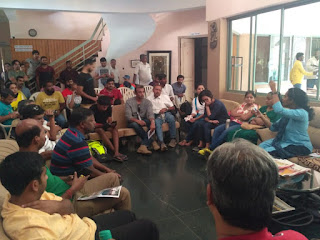ATREE and Biome organized a
Biodiversity Walk at Jakkur Lake on
Saturday,
March 30th. The walk started at 7am and was lead by
Aswathy Joseph. Aswathy is a biology teacher and is extremely passionate about nature, education and art. During the walk she shared some fascinating information about the plants in the lake area and about the animal life they support. Her stories highlighted the mutual dependence the plants and animals share.
 |
| Aswathy sharing stories with the participants |
Right where we started our walk stood species of ficus trees, commonly known as
Cluster Fig Tree. She said that the ficus trees had been a
keystone species as over 1200 species of birds, insects and mammals depended on the tree for their survival. An interesting story she shared was that of the female
Fig Wasp that enters the fig through the tiny hole at the bottom. During this process the wasp usually tend to lose its wings. The female fig wasp pollinates the flower and lays her eggs in the fig. These wasps spend the rest of their short lived lives inside the fig. The newly hatched male wasps mate with the newly hatched female wasps and create holes in the fig through which the female wasps can fly out. The female wasps then go searching for a new fig to lay her eggs in and pollinates the new fig flower in the process.
 |
| Fun fact: What we call the fig fruit is actually the flower of the tree |
While walking further we came across a
Black Babul Tree, Aswathy shared another mutual dependence story of the acacia plant and the
ants, aka
'bioengineers' that live on it. The plant produces nectaries and the young leaves have protein bodies that are used as food by ants. The tree also has thorns, to keep herbivores away, which are used by the ants create nests and lay eggs. The ants in turn act as bodyguards and protect the tree from other insects and prevent other plants from growing on it. This way the ants have access to food and shelter while the tree is protected from deterioration.
 |
| Black Babul Tree by the lake |
Another story she mentioned was that of the symbiotic relationship shared by the
Monarch Butterfly and the
Milkweed plants. The butterflies enjoy the nectar from the Milkweed plants and in return pollinates the plant. The Monarch butterfly's larvae feed on the Milkweed leaves, this keeps most predators away as they dislike the taste and hence avoid eating Monarch butterfly and its larvae.
 |
| Aswathy standing next to a Milkweed plant |
The walk was followed by a water quality testing demonstration, held at the Outdoor Learning Center. Saurabh from the Foundation for Environmental Monitoring (FFEM) showed us how a pH test worked. He also spoke about how Nitrates and Phosphates tests are conducted. We had three volunteers who gave their phones for calibration, which allows the volunteers to accurately measure the water quality of the lake.
 |
| Water quality testing demonstration by Saurabh from FFEM |
Some enthusiastic participants stayed on after the water quality testing to learn more about the different types of butterflies that existed around the lake. It was a well spent Saturday morning with over
50 participants who were engaged in learning about the biodiversity and the water quality at Jakkur Lake.
















